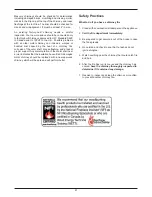
Masonry chimneys should be checked for deterioration
including damaged bricks, crumbling and missing mortar,
cracks in the drip cap at the top of the chimney, and loose
flashings at the roof line. The liner should be checked for
cracks and mis-alignment. It must be at least 6” in size.
An existing factory-built chimney needs a careful
inspection. Your new cookstove should be connected only
to factory-built chimneys approved to ULC Standard S629
in Canada and UL 103HT in the U.S.. Possible problems
with an older metal chimney can include a warped or
buckled liner caused by the heat of a chimney fire,
corrosion of the outer shell, a loose flashing, and a lack of
proper support. Any discolouration of the metal shell near
a joint indicates that the insulation has settled. A damaged
metal chimney should be replaced with a new approved
chimney which will be safe and will perform better
Safety Practices
What to do if you have a chimney fire
1. Close all the combustion air dampers on the appliance.
2.
Call the fire department immediately.
3. Be prepared to get everyone out of the house in case
the fire spreads.
4. Go outside and check to see that hot ashes do not
ignite shingles,.
5. Watch anything near the chimney that could catch fire
and burn.
6. After the fire has run its course and the chimney has
cooled,
have the chimney thoroughly inspected to
determine if it sustained any damage.
7. Resolve to inspect and clean the chimney more often
to prevent another chimney fire.
21








































